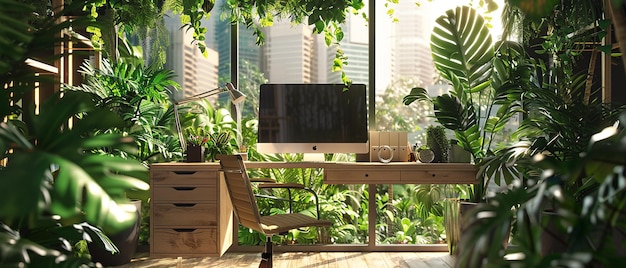Green Your Home Office: Sustainable Workspace Tips

Turning your home office into a green and sustainable workspace is achievable with simple steps like using energy-efficient equipment, opting for eco-friendly office supplies, and optimizing natural light, contributing to a healthier environment and a more productive workday.
Creating a green home office isn’t just a trend; it’s a conscious choice to minimize your environmental impact while boosting productivity and well-being! Wondering where to start? Let’s dive into practical tips for designing a sustainable workspace that’s good for you and the planet.
Why Green Your Home Office?
Working from home offers undeniable convenience, but it also comes with environmental responsibility. From energy consumption to material waste, our home offices can significantly impact the planet. Understanding the “why” behind going green is the first step toward creating a sustainable workspace.
The Environmental Impact of a Home Office
Consider the energy used to power your computer, the paper consumed by your printer, and the waste generated by disposable office supplies. These seemingly small elements add up, contributing to carbon emissions and resource depletion. Embrace change to create a more sustainable home office!
Health and Productivity Benefits
Beyond environmental concerns, a green home office can also enhance your health and productivity. Natural light, indoor plants, and ergonomic design can create a more comfortable and inspiring workspace, leading to improved focus and reduced stress.
- 🌿 Promotes better air quality and reduces exposure to toxins.
- 💡 Enhances natural light exposure, reducing eye strain and headaches.
- 🌱 Creates a calming and aesthetically pleasing environment, boosting mood and creativity.
Making your home office more sustainable is about more than just protecting the environment; it’s about enhancing your own well-being and creating a space where you can thrive.

Optimizing Energy Consumption
One of the most significant ways to green your home office is by reducing energy consumption. From energy-efficient lighting to smart power management, there are multiple strategies to minimize your carbon footprint and lower your electricity bill.
Energy-Efficient Lighting
Switching to LED lighting is a simple yet highly effective way to save energy. LED bulbs consume up to 75% less energy than traditional incandescent bulbs and last much longer, reducing the need for frequent replacements.
Smart Power Management
Ensure to unplug electronic devices and chargers when they are not in use to avoid phantom energy drain. Using a smart power strip can also help, as it automatically cuts off power to devices when they are not in use.
- 🔌 Unplug devices when not in use to prevent phantom energy drain.
- 🖱️ Consider using a laptop instead of a desktop computer, as laptops generally consume less energy.
- ☀️ Maximize natural light during the day to decrease the need for artificial lighting.
Taking these steps can significantly reduce your energy consumption, contributing to a more sustainable workspace. Every small adjustment adds up to make a big difference.
Eco-Friendly Office Supplies
The materials you use in your home office can have a significant impact on the environment. Choosing eco-friendly alternatives to traditional office supplies can help reduce waste and minimize your carbon footprint.
Recycled Paper and Notebooks
Opt for recycled paper and notebooks to reduce the demand for virgin wood pulp. Look for products made from 100% post-consumer waste to maximize their environmental benefits.
Sustainable Stationery
Choose pens, pencils, and other stationery items made from sustainable materials such as bamboo, recycled plastic, or biodegradable materials. These alternatives are not only eco-friendly but often more durable and stylish.

Consider replacing items like plastic tape dispensers with bamboo alternatives and swapping out traditional plastic desk organizers for ones made from recycled materials. These small changes can make a big impact on your environmental footprint.
By consciously selecting eco-friendly options, you can transform your home office into a model of sustainability and help contribute to a healthier planet. Your commitment to reducing waste and supporting sustainable products can inspire others to follow suit, creating a ripple effect of positive change.
Optimize Natural Light and Air Quality
Creating a healthy and productive green home office involves more than just eco-friendly supplies. Optimizing natural light and air quality can enhance your well-being and boost your productivity.
Maximizing Natural Light
Position your desk near a window to take advantage of natural light. Natural light reduces eye strain, improves mood, and helps regulate your body’s natural circadian rhythms.
Indoor Plants for Air Quality
Introduce indoor plants to purify the air and create a more calming atmosphere. Plants like snake plants, spider plants, and peace lilies are particularly effective at removing toxins from the air.
- 🪴 Snake plants are low maintenance and effective at removing toxins like formaldehyde and benzene.
- 🌿 Spider plants are easy to propagate and purify the air by absorbing carbon monoxide and xylene.
- 🌸 Peace lilies add elegance and help remove mold spores and other pollutants.
Incorporating these elements can boost your mood by adding a touch of nature to your workspace and increasing your productivity.
Ergonomic and Sustainable Furniture
Investing in ergonomic and sustainable furniture is crucial for creating a comfortable and eco-friendly workspace. Choosing the right furniture can support your physical health while minimizing your environmental impact.
Ergonomic Chairs and Desks
Select an ergonomic chair with adjustable height, lumbar support, and breathable materials. Pair it with a standing desk or a height-adjustable desk to alternate between sitting and standing throughout the day.
Sustainable Materials and Construction
Look for furniture made from sustainable materials such as reclaimed wood, bamboo, or recycled plastic. Ensure that the furniture is manufactured using eco-friendly processes and finishes.
- 🪑 Reclaimed wood furniture adds character and prevents deforestation.
- 🎋 Bamboo furniture is lightweight, durable, and fast-growing.
- ♻️ Recycled plastic furniture reduces landfill waste and offers a sustainable alternative.
Combining ergonomic design with sustainable materials can transform your home office into a haven of comfort and sustainability.
Embrace Digitalization and Reduce Paper Waste
In today’s digital age, reducing paper waste in your home office is easier than ever. Embracing digitalization can minimize your environmental impact, streamline your workflow, and improve organization.
Digital Note-Taking and Organization
Use digital note-taking apps and cloud-based storage solutions to eliminate the need for paper notebooks and physical files. Tools like Evernote, OneNote, and Google Drive offer convenient and eco-friendly ways to manage your information.
Paperless Communication
Opt for digital communication channels such as email, instant messaging, and video conferencing to reduce the need for printing documents and sending physical mail.
By embracing digitalization and reducing paper waste, you can create a clutter-free, efficient workspace and minimize the environmental impact of your home office.
| Key Point | Brief Description |
|---|---|
| 💡 Energy Efficiency | Use LED lighting and smart power strips to reduce energy consumption. |
| ♻️ Eco-Friendly Supplies | Opt for recycled paper, bamboo stationery, and sustainable materials. |
| 🌿 Natural Light & Air | Maximize natural light and introduce indoor plants for air purification. |
| 🖥️ Digitalization | Use digital tools to reduce paper waste and streamline workflow. |
FAQ
▼
Greening your home office reduces your environmental impact, promotes a healthier workspace, and can enhance productivity and well-being, contributing to a more sustainable lifestyle.
▼
Use LED lighting, unplug devices when not in use, and consider using a laptop instead of a desktop to minimize energy consumption and lower your electricity bill.
▼
Opt for recycled paper and notebooks, bamboo stationery, and desk organizers made from recycled materials to reduce waste and promote sustainable practices in your office.
▼
Yes, indoor plants like snake plants, spider plants, and peace lilies can purify the air by removing toxins and pollutants, creating a healthier and more refreshing workspace environment.
▼
Digitalization helps by leveraging apps like Evernote and Google Drive for organization and also helps in using digital communication channels like email,chat and video conferencing.
Conclusion
Creating a green home office is an investment in both your well-being and the health of the planet. By implementing these simple yet effective tips, you can transform your workspace into a sustainable, productive, and inspiring environment. Embrace these changes and contribute to a greener future, one workspace at a time.





